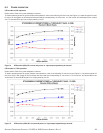SEAGATE ENTERPRISE CAPACITY 3.5 HDD V4 SAS PRODUCT MANUAL, REV. A 34
6.5.4.2 Vibration
a. Operating—normal
The drive as installed for normal operation, shall comply with the complete specified performance while subjected to
continuous vibration not exceeding
5 - 22 Hz 0.25 Gs, limited displacement
22 - 350 Hz 0.5 Gs
350 - 500 Hz 0.25 Gs
Vibration may be applied in the X, Y, or Z axis.
b. Operating—abnormal
Equipment as installed for normal operation shall not incur physical damage while subjected to periodic vibration not
exceeding:
15 minutes of duration at major resonant frequency
Vibration occurring at these levels may degrade operational performance during the abnormal vibration period. Specified
operational performance will continue when normal operating vibration levels are resumed. This assumes system
recovery routines are available.
Operating abnormal translational random flat profile
5-500 Hz @ 0.75 G (X, Y, or Z axis)
c. Non-operating
The limits of non-operating vibration shall apply to all conditions of handling and transportation. This includes both
isolated drives and integrated drives.
The drive shall not incur physical damage or degraded performance as a result of continuous vibration not exceeding
5 - 22 Hz 3 Gs (0 to peak, linear, swept sine, 0.5 octave/min)
22 - 350 Hz 3 Gs (0 to peak, linear, swept sine, 0.5 octave/min)
350 - 500 Hz 3 Gs (0 to peak, linear, swept sine, 0.5 octave/min)
Vibration may be applied in the X, Y, or Z axis.
6.5.5 Acoustics
Sound power during idle mode shall be 2.8 bels typical when measured to ISO 7779 specification.
Sound power while operating shall be 3.0 bels typical when measured to ISO 7779 specification.
There will not be any discrete tones more than 9 dB above the masking noise when measured according to
Seagate specification 30553-001.
6.5.6 Air cleanliness
The drive is designed to operate in a typical office environment with minimal environmental control.
6.5.7 Corrosive environment
Seagate electronic drive components pass accelerated corrosion testing equivalent to 10 years exposure to light industrial environments
containing sulfurous gases, chlorine and nitric oxide, classes G and H per ASTM B845. However, this accelerated testing cannot duplicate
every potential application environment. Users should use caution exposing any electronic components to uncontrolled chemical pollutants
and corrosive chemicals as electronic drive component reliability can be affected by the installation environment. The silver, copper, nickel
and gold films used in Seagate products are especially sensitive to the presence of sulfide, chloride, and nitrate contaminants. Sulfur is
found to be the most damaging. In addition, electronic components should never be exposed to condensing water on the surface of the
printed circuit board assembly (PCBA) or exposed to an ambient relative humidity greater than 95%. Materials used in cabinet fabrication,
such as vulcanized rubber, that can outgas corrosive compounds should be minimized or eliminated. The useful life of any electronic
equipment may be extended by replacing materials near circuitry with sulfide-free alternatives.
6.5.8 Electromagnetic susceptibility
See Section 2.1.1.1.


















